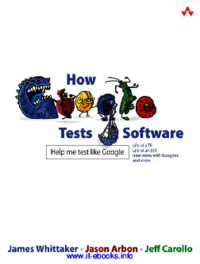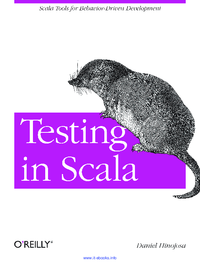Etiqueta "Pruebas de software"
Se han encontrado 2 Coincidencias
How Google Tests Software
pruebas de software
95 Visitas | 103 Descargas | 2015-03-20 13:24:16 | javierd
Software development is hard. Testing that software is hard, too. And when you talk about development and testing at the scale of the entire web, you are talking about Google. If you are interested in how one of the biggest names in the Internet handles such large-scale testing, then you have found the right book. Google tests and releases hundreds of millions of lines of code distributed across millions of source files daily. Billions of build actions prompt millions of automated tests to run across hundreds of thousands of browser instances daily. Operating systems are built, tested, and released within the bounds of a single calendar year. Browsers are built daily. Web applications are released at near continuous pace. In 2011, 100 features of Google+ were released over a 100-day period.

Testing in Scala
67 Visitas | 86 Descargas | 2015-11-02 15:47:56 | pecarrazana
This book enhances the Scala language with standard test-driven development practices, highlighting the best testing tools today. This book will cover both the ScalaTest and the Specs2 testing frameworks, which help you create quick and easy tests. Testing is also often the most overlooked aspect of introductory programming language books. This book is dedicated to mending that gap.We will run all these tests using Simple Build Tool (SBT). SBT is similar to some earlier build tools and competitors: Maven, Gradle, and Buildr. What makes SBT highly attractive is its ease of use and the small size of the build file. Type a few lines of code for your build file and you’re off and running on your project. We will also cover SBT’s wonderful triggered execution feature, which complements test-driven development by building and testing code whenever a file is saved.ScalaTest and Specs2 are two of the most dominant testing frameworks for Scala around today. Each framework has a different intent and goal, but they share the some ideal of making testing concise, and they both leverage the Scala programming language to make testing easy and fun. Testing frameworks are nothing new, of course, and have been used with other programming languages for years. Those familiar with other programming languages and their testing tools will find some similarities with Scala’s current testing tools. ScalaTest and Specs2 borrowed ideas from Cucumber. But upon these shoulders of giants, Scala testing systems have also stepped out on their own and created some of the most mind-blowing testing tools found in any language. Testing in Scala will also illustrate mocking code, so as to keep our tests isolated from large subsystems and networks. Mocking is, in essence, creating a substitute for various objects to isolate tests from volatile elements of their environment (such as the contents of databases) and to help unit tests run fast. This book shows how you can use Scala with Java-based mocking frameworks that have been used for years by Java programmers, EasyMock and Mockito. We will also introduce you to a new framework, ScalaMock. Formerly known as Borachio, ScalaMock was inspired by Java’s EasyMock and Mockito but takes their work further, even offering support for mocking final classes and Scala objects.
Contribuir
Usted puede contribuir con Libros UCLV, es importante para nosotros su aporte..
Contribuir